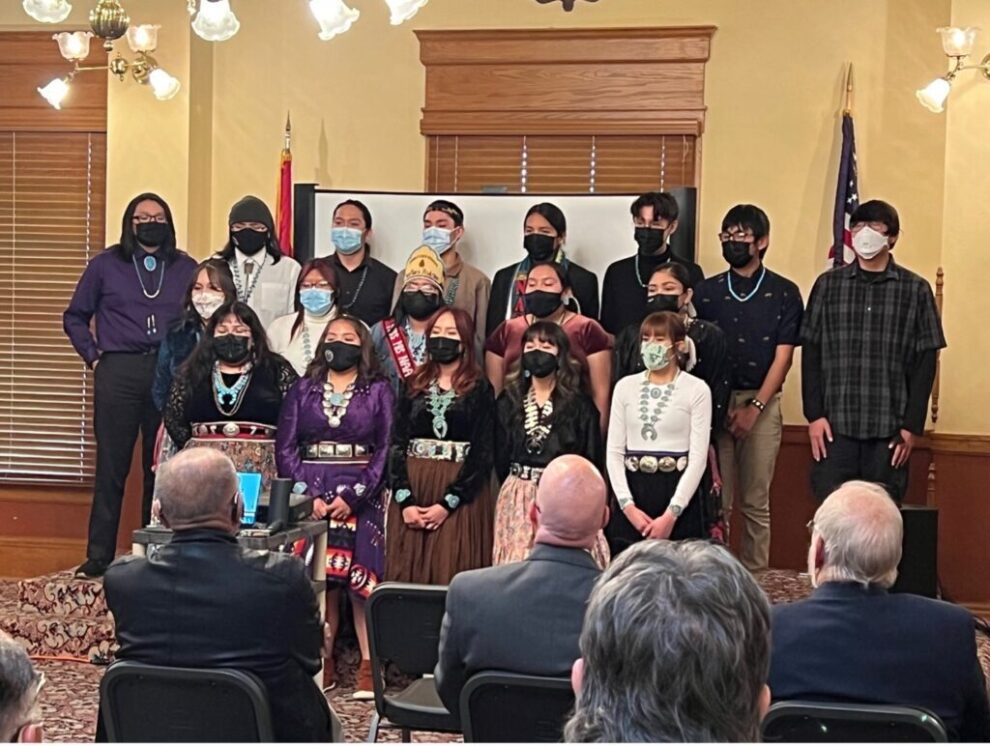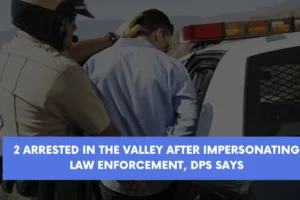When Page High School Teacher Carlos Begay surveyed his students at the beginning of their Navajo culture, language and government courses, students told him they sought more cultural and traditional knowledge.
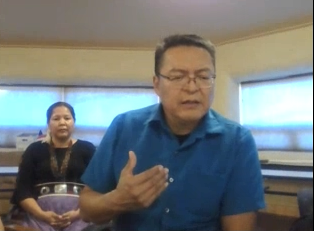
Page High School Teacher Carlos Begaye talks about how the Navajo Language Unity Club started as Page Unified School Board President Desiree Fowler listens. Photo courtesy ASBA
“When it came to the advanced classes, they were more or less looking towards now learning the songs, now learning the detailed lineage that we will never, ever hear in a classroom setting,” Begay said. “They were actually wanting more, more cultural knowledge as though it’s food that they’ve never tasted before is how I used to explain it.”
Begay said he noticed when he was teaching classes remotely during the COVID-19 pandemic that it wasn’t just the students paying attention.
“They actually had parents, they actually had grandparents in the background who were taking in the classes, so there was a tremendous need for that cultural knowledge,” Begay said.
Begay incorporated wintertime stories that he learned from his elders and forefathers into the lessons he taught and aligned then to the standards. Students let him know how much they liked it, and they said they wanted to learn more.
That desire for more of language and cultural knowledge led students to create a Navajo Language Club at Page High School, then they inherited the Student Unity Club, and they combined them together to create the Navajo Language Unity Club.
“There’s the language part, which literally identifies and defines the culture as well, but there’s also the unity part which is basically uniting across the district all of the other American Indian students as well,” Begay said. “We had to find that balance.”
Begay said they came to “find out a lot of the tribes actually have a lot of similarities among the cultural stories, traditional stories and lineage and that in itself kind of took us to a whole different level from there.”
One Page High School graduate said the songs and stories she learned in her classes and performed as a member of the club helped her and her family learn more about their culture.
“What I learned from Mr. Begay, it made me want to do the same thing,” said Bryce, who is in her first year of college. “It really helped me because some people ask questions, and they want to know how certain things go on the Navajo side. It really helped me to get to know part of each tribe I’m a part of.”
“Learning the songs and stories really helped me, because when I’m feeling down or stressed, I’ll sing the songs to myself and it just really relieves me,” Bryce said.
As part of National American Indian Heritage Month celebrations at Page High School, Navajo Language Unity Club members held several culture nights throughout November including a Singing Mountain Song event and a Winter Story Night earlier this month, a Drum Session earlier this week, and a Shoe Game coming up on Nov. 30. Also, the club invited the community to celebrate Multicultural Celebration Day on Nov. 20 to commemorate the rich and diverse American Indian’s Cultures, traditions, heritages, histories and acknowledge their important contributions to society.
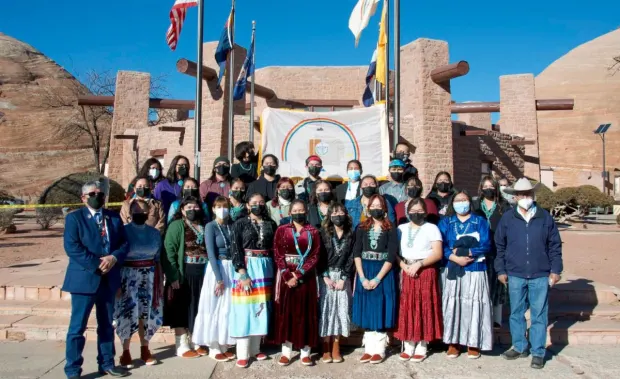
Pictured: Council Delegates Daniel Tso and Paul Begay recognize Page High School’s Navajo Language students during the 2022 Winter Council Session. (Photo: 24th Navajo Nation Council)
For resources to honor Native American Indian Heritage Month, including classroom activities, teacher resources, influential figures, events, books, a proclamation school governing boards can approve, graphics and more click here to check out ASBA’s resource page.
A Page High School student who is part of the club said what he’s learned from Mr. Begay and as part of the club helps him with his dual enrollment classes at Coconino Community College.
“The traditional knowledge helps me a lot in school, because I can relate a lot, and there’s a bunch of similarities for example – psychology, astronomy, sociology – it makes connections,” he said. “It helps me with self-identity. It makes me emotionally and mentally strong.”
Another Page High School student and club member said she’s learned so much, “because I didn’t have that much knowledge of my own culture,” but now she had “knowledge to pass down to my younger siblings.”
She also said students “come up with ideas, put them together and plan out stuff, and have things approved so we can do fundraisers, trips, educational trips to places, and advocate for other students who don’t have a voice for themselves.”
How students’ advocacy work began
Page Unified School District strives to get students involved, said Desiree Fowler, president of the Governing Board for the school district that serves more than 2,800 students in Page, Ariz., about 120 miles north of Flagstaff.
 Page Unified School District Governing Board President Desiree Fowler. Image courtesy ASBA
Page Unified School District Governing Board President Desiree Fowler. Image courtesy ASBA
The Superintendent approved of students in Mr. Begay’s Navajo Government class taking part in the virtual National Association of Federally Impacted Schools conference during their class time, Fowler said.
“When we went into this virtual visit, five of our students had volunteered to speak to one of our representatives in Washington D.C.,” Fowler said. “It was really shocking in a way, but also it was good insight for me as a board member to have our students vocalize the barriers and the challenges that they face on a daily basis to be at school.”
“At that time, some of our students decided to step up to the mic and really address some of the challenges and the barriers, but also the successes that were also happening in the (school) district,” Fowler said.
“I found out we had students coming in from Tuba City, and that just kind of empowered my thought of how we really need to involve the students to get involved at that level of advocacy,” said Fowler, who volunteers with the student club.
The students advocate not only for themselves, but for their families, communities, and tribes, with their local chapter, local Council Delegate Paul Begay Jr. invited the students to Window Rock, students shared what they’d like Arizona Legislators to know as they adopt bills at Arizona School Boards Association’s Advocacy Day at the State Capitol where they also met with Legislators, and at events and discussions with Navajo Nation leaders and U.S. congressional leaders.
“Also, it has brought an understanding to students to realize and recognize that being a part of something small, I guess they never realized just how big of an impact they would make at the Navajo Nation level,” Fowler said.
 Page High School students, their teacher Carlos Begay and Page Unified Governing Board Member Desiree Fowler advocate at the Navajo Nation’s office in Washington, D.C. in September 2022. Photo courtesy Page Unified School District
Page High School students, their teacher Carlos Begay and Page Unified Governing Board Member Desiree Fowler advocate at the Navajo Nation’s office in Washington, D.C. in September 2022. Photo courtesy Page Unified School District
A Page High School student who is part of the club said what he enjoys most about the club is how “how we advocate for what others are facing – basically like challenges.”
“We’re basically the voice and leadership that they need,” he said.
When students present to organizations and businesses, people are in awe, Begay said.
“If you teach students about their roots, it will actually bring them back to self-motivation,” Begay said.
Challenges club members have faced
Among the challenges students have faced with the club are losing sight of the objectives, said Kathleen, a club member who has since gone on to college.
When the club visits “certain places there’s some people who don’t want to engage in conversations, and it kind of messes things up a little bit if not everyone is 100% in,” Kathleen said.
 Navajo Language Unity Club members and Page High School Teacher Carlos Begay. Photo courtesy ASBA
Navajo Language Unity Club members and Page High School Teacher Carlos Begay. Photo courtesy ASBA
“Also, another challenge would be fundraising to make up the money for travel and if you’re going to get hotel rooms and also food and meals, you need to figure out the pricings for all of that,” Kathleen said.
Student involvement can be an issue too, “sometimes at club meetings there’s only like a few of us and sometimes there’s not enough to make quorum,” he said.
“It’s really hard because we put like a lot of pressure on our sponsors with paperwork and it’s like last minute decisions and they have to stress about it and funding,” he said.
When not enough people show up at workshops or meetings or there are last minute decisions about events club members want to participate in that puts “stress on our sponsors and then we also have to fundraise for the stuff that we want to do,” another club member said.
“The students literally nailed it on the head,” Begay said.
Why language and cultural knowledge are so important
“If you go back to literally the beginning of time when education began, the idea was to literally eliminate the language, the culture, the heritage, the lineage of the American Indian,” Begay said.
It was not until the 1970s and 1980s that change began, Begay said.
“Well into my high school years, there was really minimal, you could not even hear a pin drop when it came to culture,” Begay said.
“When I got into the education field, I found out that a lot of our youth had lost their way, their indigenous ways basically,” Begay said.
So, Begay found ways to integrate cultural knowledge into lessons.
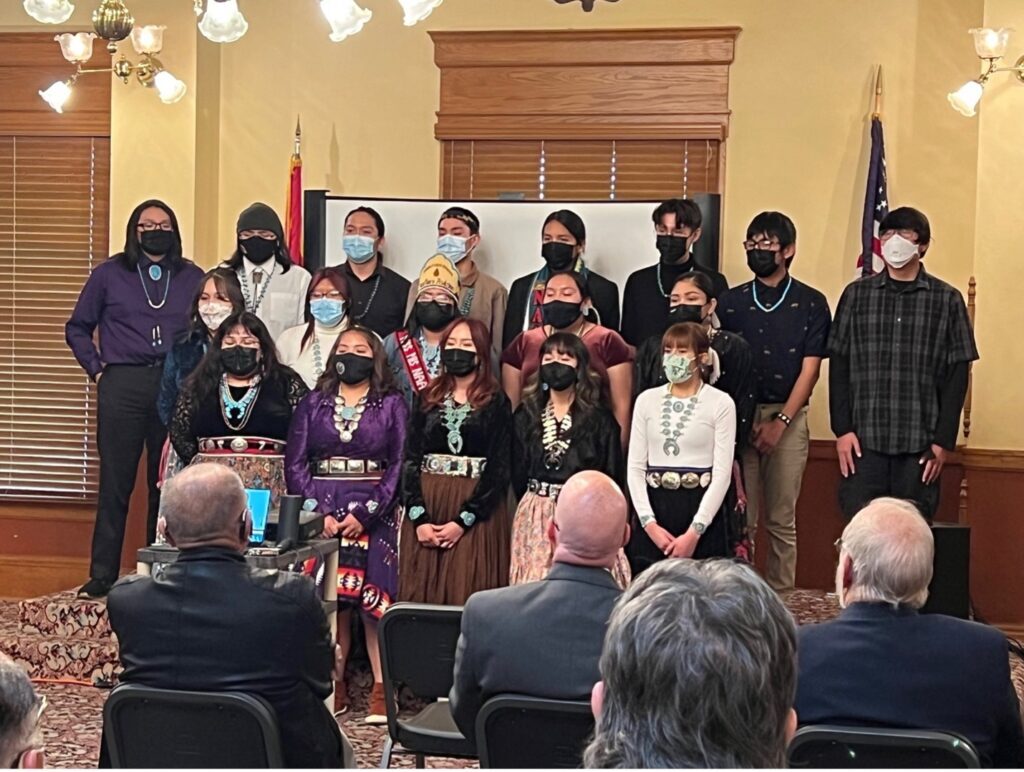 Navajo Language Unity Club Members speak during ASBA Advocacy Day. Photo courtesy of ASBA
Navajo Language Unity Club Members speak during ASBA Advocacy Day. Photo courtesy of ASBA
“If you understand American Indian culture, it really accommodates everything as a whole, we don’t segregate things,” Begay said. “Mathematics, for example, to science, scientific knowledge to social studies, all the core academic areas, everything is integrated. We live it, we practice it every single day. From that perspective, the kids had a hard time understanding culture at first.”
So, Begay built lessons off of PowerPoint, which students are used to.
“We actually started building digital stories. Students had fun with that,” Begay said. “A lot of hands-on activities is where we began, and as time went on, we actually took it out into the real world going into a chapter house setting.”
Then performing and advocating at the “Navajo Nation level, dealing with the political arena and also even at the state and national level,” Begay said.
For schools interested in starting a club like this for students it’s key to hire a person who is culturally knowledgeable, Begay said.
“Somebody who is culturally versed – not only language, not only understanding the culture – but actually living it,” Begay said.
It’s also important that person can put “it into a classroom setting to integrate it with a lesson plan with the Navajo Nation that’s where our standards and curriculum does come in with being aligned with the state standards and curriculum,” Begay said.
What to keep in mind
A student in the club said it’s important “to have people that are committed to everything and make sure they don’t back out of stuff, because when they back out of stuff, they throw everything off.”
“We took a trip to Washington, D.C., in September, and I think that really helped all of us get out of our comfort zone as advocating as a student in front of adults,” she said.
Another student said it’s key to understand someone else’s life, give respect, have different perspectives about it, and give “people a different way they view you.”
Kathleen said it’s important to stay on top of paperwork like travel request forms, parent permission slips, itinerary agendas and more.
Otherwise, if “you’re falling behind on your paperwork and the date is coming up that you’re needing to travel” then you’re “on the ledge of not going to the event or the place that you’re trying to get to.”
There’s also paperwork that goes through the district office for funding, codes are involved and has to meet their own standards and criteria from the state, Begay said.
“At your state level, you have your state rates, you have your motel rates and all those things. Basically, make sure your Ts are crossed, and your I’s are dotted.”
Keeping people up to date and meeting deadlines is also important, Begay said.
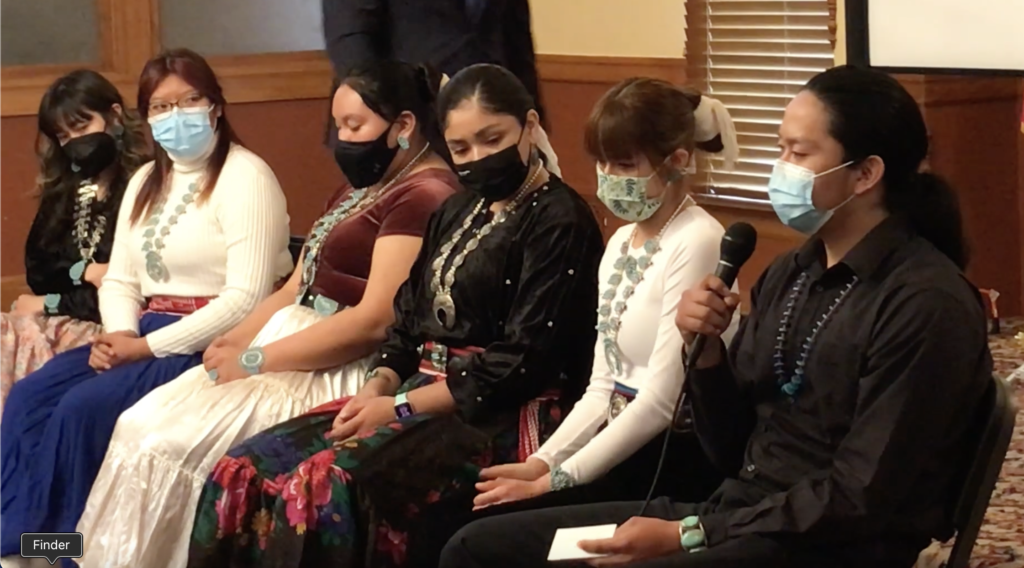 Page High School students, who came to the Arizona Capitol on Tuesday, Feb. 22, 2022 during Arizona School Boards Association’s Advocacy Day, shared their experiences with Algebra II and the COVID pandemic that they said Arizona Legislators should keep in mind as they propose policy changes and vote on bills this session. Photo by Lisa Irish/ AZEdNews
Page High School students, who came to the Arizona Capitol on Tuesday, Feb. 22, 2022 during Arizona School Boards Association’s Advocacy Day, shared their experiences with Algebra II and the COVID pandemic that they said Arizona Legislators should keep in mind as they propose policy changes and vote on bills this session. Photo by Lisa Irish/ AZEdNews
“I’ve worked with American Indian communities for the longest time, and sometimes we have a problem meeting deadlines. I have people who come in past the deadline, and you have to continue advocating for them as the sponsor, so you have to step up front, you have to be that person, you have to plan way in advance,” Begay said.
Last minute decisions are also tough, Begay said.
“When companies and businesses actually call and they request for your presence at a certain time, it has to be in advance,” Begay said. “It cannot be last minute, because that puts an impact, not only on the sponsors, not only on the administrators, but also on the superintendent and school board members as a whole.”
Another consideration is “getting full buy in from students’ parents to be able to continue to motivate and support their students,” Fowler said.
“It’s also reaching out of your comfort zone and getting acquainted with and making those phone calls to people in different locations. For us, I mean, we would have never thought we’d go into the level of advocacy, but that’s exactly the direction that it took us,” Fowler said.
Key highlights
“I cannot believe the amount of exposure our students have received through this club at multiple levels,” Fowler said. “The unity of the students learning about one another and making a program or a club work is really getting involved I guess at a different level and utilizing our cultural kinship.”
Inclusion, diversity, and equity can be implemented in student clubs as well as at the school level, and when they are, it brings out what students are doing, gives them opportunities to share their voices, tell their stories, and encourages them, Fowler said.








